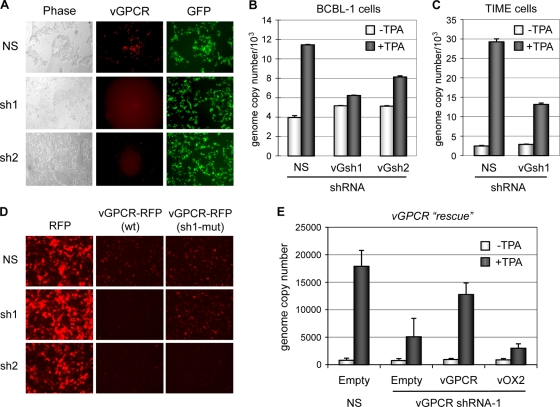FIG. 3.
Depletion of vGPCR expression in PEL and HHV-8 infected TIME cells. (A) Two shRNAs directed to vGPCR mRNA sequences (5′-AGCGGATATGACTACTCTGGA-3′, sh1; 5′-AACGTTGGAATACTCTCTCTGAT-3′, sh2) were tested for their efficacies in HEK293T cells transfected with lentiviral-based expression vectors (GFP+) encoding each shRNA together with vGPCR-RFP expression plasmid. Fluorescence micrography revealed substantially decreased vGPCR-RFP expression in vGPCR shRNA-transduced cells relative to levels in NS shRNA-transfected cells. The panels containing sh1/2 plus vGPCR have been deliberately overexposed to demonstrate shRNA efficacy. (B) Both shRNAs, cloned into and expressed from puromycin-selectable lentiviral vectors, were utilized to investigate the functional significance of vGPCR for HHV-8 productive replication in TPA-treated PEL (BCBL-1) cultures. Lentivirus-infected cultures were grown in the presence of puromycin to ensure 100% shRNA transduction prior to TPA treatment. Media were harvested 3 days postinduction for qPCR analysis of ultracentrifuge-pelleted and DNase I-resistant encapsidated viral DNA. Virus replication was diminished in each case, relative to NS shRNA-transduced control cultures. Data were obtained from triplicate qPCR reactions; error bars show standard deviations from mean values. (C) Analogous experiments were undertaken in latently infected endothelial (TIME) cells, using one of the vGPCR-directed shRNAs (sh1). Similar results were obtained, demonstrating vGPCR shRNA-specific negative effects on virus replication. The data presented are from duplicate samples and qPCRs. (D) Testing of resistance of shRNA target site-altered vGPCR coding sequences to effects of shRNA-mediated depletion in HEK293T-based cotransfection experiments using wild-type (wt) and engineered ORFs 74 fused to RFP coding sequences. The ORF74 sequence (AGCGGATATGACTACTCTGGA) targeted by shRNA 1 was changed to AGT GGT TAC GAT TAT TCC GGA (changes in codons [triplets] are underlined). (E) Rescue of the vGPCR mRNA depletion phenotype in TIME cells by (shRNA resistant) vGPCR complementation but not by vOX2/CD200, encoded in HHV-8 by a bicistronic message also containing ORF74 (10, 16). Data were derived from duplicate samples and qPCRs; error bars represent deviations from mean values.

